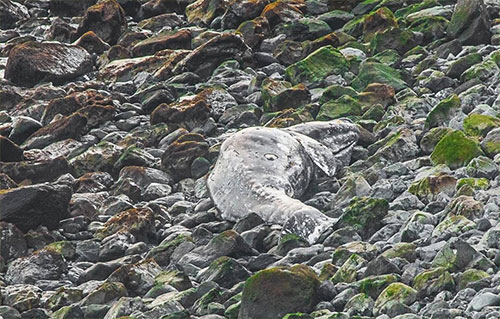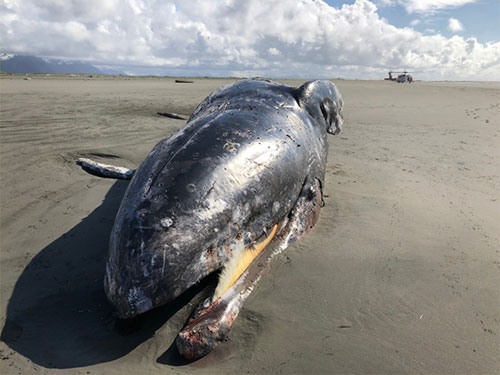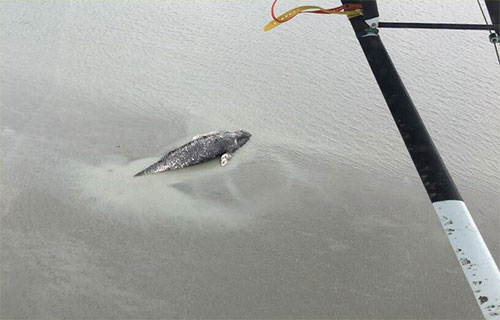
Third Dead Gray Whale Found in Alaska This MonthNOAA Fisheries is closely tracking increase in gray whale strandings along the West CoastPosted/Edited By MARY KAUFFMAN
May 24, 2019
Most recently, NOAA received a report of a gray whale stranded along the coast of Kodiak. The report came in late Tuesday to NOAA's Office of Law Enforcement Kodiak Office and the Sun'aq Tribe of Kodiak, a NOAA marine mammal stranding partner. Necropsies were performed on the first two whales; however, the Kodiak whale is located along the rocky shore below a steep cliff and considered inaccessible for a necropsy.
This is the third dead gray whale reported this month in Alaska, along with a carcass reported beached on the Copper River Delta and another in Turnagain Arm. NOAA first received report of the Copper River Delta dead whale on May 14, but the tide carried it offshore. A Kodiak-based helicopter crew from the U.S. Coast Guard relocated the whale on Friday, May 17. The USCG responders collected tissue samples and photos for NOAA biologists. “We are thankful for our strong partnerships,” said Alaska Regional Assistant Stranding Coordinator Sadie Wright. “The Coast Guard air crew kept an eye out for this animal and got our team out there asap after locating it."
Although the recent whale necropsy near Cordova did not immediately reveal a cause of death, it did provide scientists with the opportunity to collect samples to determine if the whale was exposed to harmful algal blooms or other illnesses. Lead veterinarian Kathy Burek-Huntington from Alaska Veterinary Pathology Services reports that the animal did not appear emaciated, but that blubber samples will be analyzed for more information on nutritional status. The first dead gray whale this month was discovered in Turnagain Arm near Anchorage on May 9. At that time, at the time of discovery there was no way to reach this whale because of the dangerous quicksand-like mud in that area and the public was cautioned by NOAA against approaching that dead whale by land. The team was eventually able to access the whale.
“We are thankful for our strong partnerships,” said Alaska Regional Assistant Stranding Coordinator Sadie Wright. “The Coast Guard air crew kept an eye out for this animal and got our team out there asap after locating it." In the past twenty years, three reported gray whales were stranded in Turnagain Arm in 2010, 2005, and 2003. This gray whale is the second large whale that died in Turnagain Arm this month. On May 1 and 2, agency marine mammal experts and stranding network partners conducted a necropsy on a humpback whale. Although no definitive cause of death is determined at this time, the stranded humpback whale likely died from stress associated with multiple live strandings in the shallows of Turnagain Arm. NOAA Fisheries is monitoring the situation closely because of the unusually high number of gray whale deaths along the West Coast of North America this year. To date, at least 60 dead gray whales have been found from Mexico to Alaska this year. Gray whales make one of the longest annual migrations of any mammal, traveling up to 10,000 miles round-trip, between winter nursing lagoons in Mexico to summer feeding grounds in the Arctic. They are primarily bottom feeders that consume a wide range of invertebrates, such as amphipods--a small shrimp-like creature. North Pacific gray whales can grow to about 49 feet long and weigh approximately 90,000 pounds. Removed from the Endangered Species list in 1994, they currently number about 27,000. Western North Pacific gray whales still remain endangered, with around 200 individuals in the population. The eastern North Pacific population of gray whales was once listed under the Endangered Species Act, but successfully recovered and was delisted in 1994. Howeber, they remain protected under the Marine Mammal Protection Act. NOAA reminds members of the public that it is illegal to take parts from dead marine mammals. If you see dead, injured, or stranded marine mammal in Alaska, immediately report it to NOAA's Alaska Marine Mammal Stranding Network: 877-925-7773.
Source of News:
|
||||||


